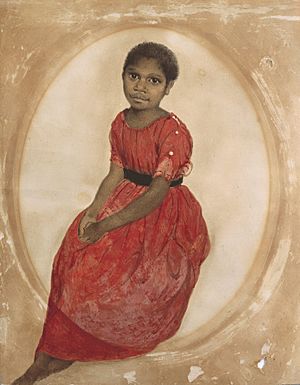Thomas Bock facts for kids
Thomas Bock was an English-Australian artist. He was also one of the first people to use photography in Australia. Born in England, he was sent to Australia in 1823. After becoming a free man, he became one of Australia's first professional artists. He was well-known for painting portraits of people living in the colonies. By 1843, he started taking special photographs called daguerreotypes in Hobart. This made him one of the first commercial photographers in Australia.
Early Life and Journey
Bock was born in Sutton Coldfield, England, in 1790. When he was young, he sang in the choir at Lichfield Cathedral. Later, Bock worked as an engraver in Birmingham. An engraver carves designs onto metal plates. He worked with William Wyon, who later became an engraver for the British Mint.
After finishing his training, Bock moved to London. There, he became an engraver and a painter of small portraits. In 1817, he won a silver medal for one of his engravings.
In April 1823, Bock was found guilty of a crime. He was sentenced to be sent to Van Diemen's Land (now Tasmania). He arrived in January 1824 on a ship called the Asia. In Tasmania, he was put to work making plates for banknotes. He also engraved plates for the Hobart Town Almanacks, which were like yearly books.

Art Career in Australia
Once he was free, Bock became one of Australia's first professional artists. He became famous for his portraits of colonists. Lady Jane Franklin, whose husband was the Governor of Van Diemen's Land, also asked him to paint portraits. He painted some Tasmanian Aborigines for her.
Bock's first art studio was in Lower Liverpool Street, Hobart. Later, he moved to a house at 22 Campbell Street. Most of his famous portraits were painted there. In 1843, Bock visited Sydney. He returned to Hobart to show his art at the first big art exhibition there in 1845.
Bock used different art materials. He painted with oils, watercolours, and crayons. He was also one of Australia's first photographers. People thought his crayon drawings were his best work. They felt he captured the true personality of the people he drew with crayons.
Early Photography Work
As early as October 1843, Bock began taking daguerreotypes in Hobart. A daguerreotype was an early type of photograph. Even though another person, George Baron Goodman, had the official license to use this process in Australia, Bock got a camera. He started making portraits. These were some of the very first photographs taken in Australia.
Bock stayed interested in photography. In 1849, he advertised that he was taking portrait daguerreotypes. He did this from his studio at 22 Campbell Street.
Thomas Bock passed away on 18 March 1855, at 65 years old. He worked hard but did not become rich. To help his wife and family, an exhibition of his paintings and drawings was held. It opened on 1 May 1855, in Hobart, to raise money for them.
Bock was one of the artists who showed his work at Hobart's first major art exhibition. His official work led to many private jobs. By the time he died in Hobart, Tasmania, he was a successful portrait artist. He was especially good at painting miniatures, which are very small portraits. Bock was one of the most skilled early artists who had been sent to Australia as a convict. Many of his artworks are now lost or not yet identified. However, he achieved two "firsts" in Australia. He was one of the first artists in the colonies to try daguerreotype photography.
See also
- List of convicts transported to Australia

